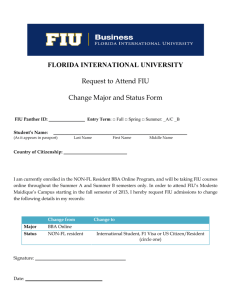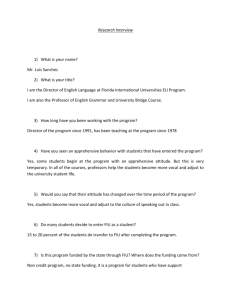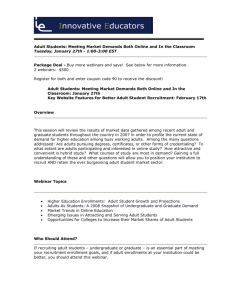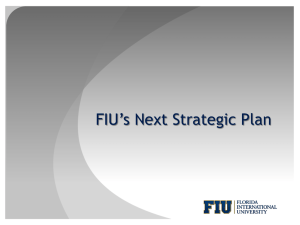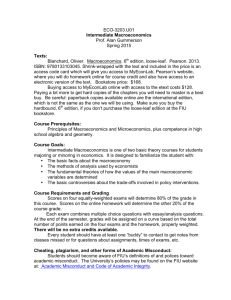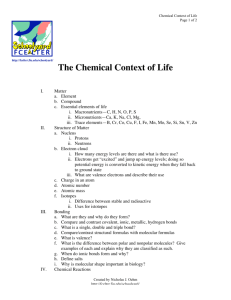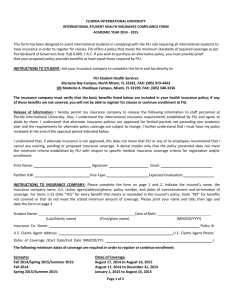PDF of the presentations from this session
advertisement
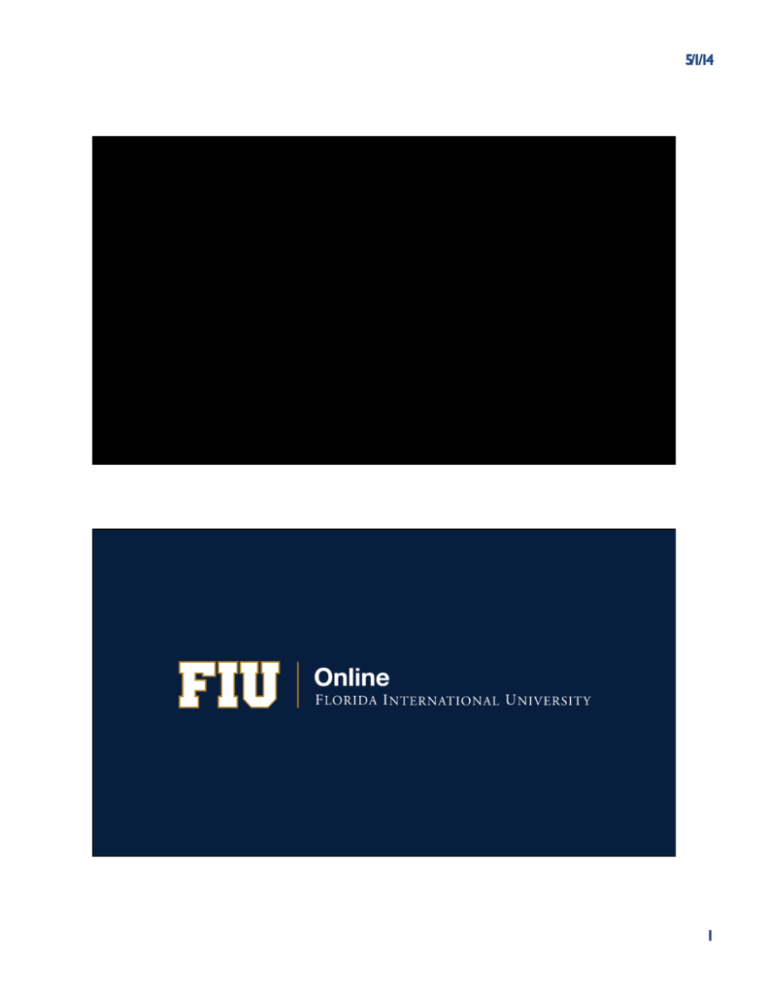
5/1/14! 1! 5/1/14! SOME INSIGHTS INTO THE INTERNATIONALISATION! OF HIGHER EDUCATION! Jerry Haar, Ph.D.! Professor of Management & International Business! Florida International University! The British Council! April 29, 2014! Miami, Florida! … A KEY DRIVER OF INTERNATIONALISING HIGHER EDUCATION?! GLOBALIZATION! … trade, finance, commerce, communication, ! transportation, technology, and people! BUT…………………………....... “Careful, mate!” ! 2! 5/1/14! Affordable air travel Rising incomes Growth of middle class Increasing international coverage of news and travel (CNN, BBC) • Growing popularity of study abroad -- competitive edge in job market • • • • Still too costly for many Preference for vacation travel Majority of students still parochial Many students need to work full-time or part-time -- no time for travel • Preference for internships over study abroad • • • • THE GREATEST POTENTIAL FOR GROWTH ! IN INTERNATIONAL EDUCATION…! EMERGING MARKETS! • Fastest growing region… 2 - 4 times that of US and Europe • Higher education enrollments grew 109% during first half of decade; 28% in developed nations • BRICS and Middle Eastern/Gulf countries remain centre of activity • Demand from emerging markets - multi-faceted • Governments heavily subsidize student, faculty, and institutional engagements internationally 3! 5/1/14! Internationalizing Higher Education Survey by the International Association of Universities (2013) cites five (5) reasons to internationalize: 1. 2. 3. 4. 5. Improve student preparedness Internationalize the curriculum Enhance the international profile of the institution Strengthen research and knowledge production Diversity faculty and staff One Suggested Model from the American Council on Education…! 4! 5/1/14! International Student Flows A Statistical Portrait from Open Doors 2013, a report on educational ! exchange by the Institute of International Education! International Student Enrollment! 819,644 international students in 2012 / 13 7.2% growth in international students 1,000,000 800,000 New International Students 600,000 400,000 Continuing International Students 200,000 0 0 5! 5/1/14! Top Three Places of Origin! 250,000 China 235,597 200,000 150,000 100,000 India 96,754 South Korea 70,627 50,000 0 Where are the students going?! 2011 Total Int’l Students 2012 Total Int’l Students % Change Top Places of Origin United States 764,495 819,644 7.2% China, India, South Korea United Kingdom 480,755 488,380 1.6% China, India, USA China 292,611 328,330 12.2% South Korea, USA, Japan France 284,945 289,274 1.5% Morocco, China, Algeria Germany 252,032 265,292 5.3% Turkey, China, Russia Australia 242,351 245,531 1.3% China, Malaysia, India Canada 193,647 214,955* 11.0% China, South Korea, India Japan 138,075 137,756 -­‐0.2% China, South Korea, Taiwan Source: IIE’s Project Atlas – iie.org/projectatlas. *Es:mated figure. 6! 5/1/14! Major Fields of Study! +1% 70,000 +10% +3% 2010 / 11 60,000 2011 / 12 50,000 -­‐1% 40,000 +10% 30,000 -­‐2% -­‐3% 20,000 0% 10,000 0 Who is studying what?! Engineering Fine Arts Health Intensive English Math/ Comp. Science Country Business Canada 15.8 7.5 8.8 15.0 0.1 2.6 China 29.0 19.2 4.9 1.3 3.2 11.2 Germany 26.0 7.9 4.2 2.3 0.9 3.1 India 13.7 35.6 1.7 4.7 0.1 23.1 Iran 4.7 55.2 5.4 2.3 1.6 9.6 Japan 17.4 3.7 8.1 2.8 14.6 2.2 Saudi Arabia 17.1 21.1 2.1 5.6 27.2 7.4 South Korea 16.4 10.8 13.4 5.0 4.5 4.9 U.K. 17.7 4.5 8.6 4.0 0.1 2.9 Vietnam 38.1 9.9 3.5 4.3 4.6 7.5 7! 5/1/14! Financial Contributions! International students contributed over $24.7 billion to the U.S. economy in 2012. (U.S. Department of Commerce) 64% of international students (81% of undergraduates) rely primarily on personal and family funds to pay for their studies. U.S. College or University 21% Personal & Family Funds 64% Foreign Gov't/ Univ. 7% Current Employment 5% Other Foreign Source 2% Other U.S. 1% U.S. Host Institutions 5% of institutions host 69% of international! students in the U.S.! 8! 5/1/14! The Five Themes of Internationalization! 1. IMPROVE STUDENT PREPAREDNESS • • • Begin with the basics… Assure curriculum is aligned (globalized)… Encourage and facilitate off-campus international experiences…! 2. INTERNATIONALISE THE CURRICULUM • • • • Majors and minors Elective (or compulsory course) on globalization Internationalize courses Language requirement! 3. ENHANCE THE INTERNATIONAL PROFILE OF THE INSTITUTION • • • • Active membership in international organization (administrators, EFMD, AACSB) Support of faculty to travel to international conferences Professional marketing and communications in international sphere Panoply of programs: dual/joint degrees, study abroad, overseas internships, faculty exchanges! 4. STRENGTHEN RESEARCH AND KNOWLEDGE PRODUCTION • • • Fund faculty research on international topics or international dimensions of subject matter Promote joint research, particularly with partner institutions Provide funding for joint research and research with an international focus! 9! 5/1/14! 5. DIVERSIFY FACULTY AND STAFF THROUGH INTERNATIONALISM • • • • Recruitment strategies… Support faculty development on “international”…. Encourage exchanges with foreign institutions…. Invite selected administrators and staff from other institutions to “transfer knowledge” in areas of priority for host institution! The Charge to Institutions • • • • • Focus on institutional quality + financial health first! Internationalize institution’s main strengths first! Create synergy among the five IAU themes! Develop a globalized plan for the entire university! Be aggressive---you are competing with other universities!! 10! 5/1/14! Thank you for your ! kind attention!! 11! 5/1/14! Agenda • Online Education: The Next Generation! • Trends and Challenges! • Online Delivery ! 12! 5/1/14! Online Education: The Next Generation Start-up or Mainstream? • • • • Media coverage! Strategic plans of institutions! Research findings! Scalability vs Brick and Mortar! 13! 5/1/14! How Many Students Are Learning Online? Total and Online Enrollment in Degree-­‐GranTng Postsecondary InsTtuTons Fall 2002 – Fall 2012 Overall Online 22,500,000 20,000,000 17,500,000 15,000,000 12,500,000 10,000,000 7,500,000 5,000,000 2,500,000 0 Fall 2002 Fall 2003 Fall 2004 Fall 2005 Fall 2006 Fall 2007 Fall 2008 Fall 2009 Fall 2010 Fall 2011 Fall 2012 Source: Babson Survey Research Group, Pearson, and Sloan-­‐C. Online Enrollment As A Percent of Total Enrollment 40.0% % Increase 35.0% 30.0% 25.0% 20.0% 15.0% 10.0% 5.0% 0.0% Fall '02 Fall '03 Fall '04 Fall '05 Fall '06 Fall '07 Fall '08 Fall '09 Fall '10 Fall '11 Fall '12 Source: Babson Survey Research Group, Pearson, and Sloan-­‐C. 14! 5/1/14! Online Education is Critical to the Long-Term Strategy by Online Offerings: 2012 and 2013 Online EducaTon is CriTcal to the Long-­‐Term Strategy by Online Offerings: 2012 and 2013 100% 2012 90% 2013 80% 70% 60% 50% 40% 30% 20% 10% 0% Online Courses and Full Programs Online Courses Only No Offerings Source: Babson Survey Research Group, Pearson, and Sloan-­‐C. Online Offerings by Institutional Control Private non-­‐profit 21% Public 44% For-­‐profit 35% Source: Learning House and Aslanian Market Research 15! 5/1/14! The Steps of Online System Collaboration Source: (2013). State U Online. New America Founda:on. Student Profile Based on National Survey Highest Level of EducaTon Age Under 25 High School Diploma/GED 24% 12% 1 or 2 years of college but no Associate's degree 25 to 34 33% 30% Associate's degree 35 to 44 3 or 4 years of college but no Associate's degree 24% 45 to 55+ 5% 10% 15% 20% 25% 17% Bachelor's Degree 22% 0% 16% 30% 35% 15% Bachelor's Degree + 8% 0% 10% 20% 30% 40% Source: Learning House and Aslanian Market Research 16! 5/1/14! Student Profile Based on National Survey Employment Status Income Employed full-­‐:me 60% Employed part-­‐:me 20% Not Employed, but looking 25% $40,000 to $69,000 12% 28% $70,000 to $99,999 20% More than $100,000 20% 7% Not Employed and not looking Re:red Less than $40,000 1% 0% 20% 40% 60% Prefer not to say 80% 7% 0% 5% 10% 15% 20% 25% 30% Source: Learning House and Aslanian Market Research Student's Primary Motivation 0% 5% 10% 15% 20% 25% 30% To advance in current career 40% 45% 50% 46% To change careers 29% To keep up-­‐to-­‐date in current career To meet creden:al/licensure requirements for my current job 35% 12% 5% Personal reasons not related to job or career 4% Other 4% Source: Learning House and Aslanian Market Research 17! 5/1/14! Key Trigger Event 0% 5% 10% 15% 20% 25% 30% 35% 33% Qualify for promo:on/salary increase State of the economy 19% Reached a "milestone" age (e.g., 30, 40, 50) 15% Lost job/family member lost job 9% Moved to new loca:on Children lei home 4% 3% Got married 2% Got divorced or separated 2% Other 13% Source: Learning House and Aslanian Market Research How Students Search for Progams 0% 10% 20% 30% 40% 50% Going immediately to specific ins:tu:on's website 70% 61% Going to an Internet search engine (Google, Bing, etc.) 48% Going to a college search site (eLearners.com, ClassesUSA.com) 28% 26% Talking to friends or family Talking to employer or supervisor Other 60% 18% 2% Source: Learning House and Aslanian Market Research 18! 5/1/14! Location • About 80% of online students live within 100 miles of a campus or service center of the institution they attend ! ! • When considering a college, most prospects stay within a 50 mile radius ! ! Source: Learning House and Aslanian Market Research Factors in Choosing a School Percent Important Factors ReputaTon of insTtuTon 75% TuiTon and fees 73% Recognized in your field of study as high quality insTtuTon Majors or concentraTons related to occupaTons with large numbers of job openings Successful career placement Amount of transfer credits accepted 61% 56% Simplicity of admissions process/documents Scholarship opportuniTes 65% 56% 53% 53% No set class meeTng Tme 52% Faculty that teach part Tme and are pracTToners in their field 52% PosiTve interacTons with financial aid personnel 51% 19! 5/1/14! Trends & Challenges Trends • • • • • • Online is changing the face of traditional on-campus education ! The growing ubiquity of social media! Data-driven learning and assessment ! Adaptive learning and competency based learning ! Humanizing the online experience! Games and gamification! New frontiers for e-learning! 20! 5/1/14! Challenges • Competition from new models of education! • Break with tradition! • Regulations! Online Delivery 21! 5/1/14! Why go online? Strategy Setting Student Life Cycle Graph! Versus! 22! 5/1/14! What to Offer • • • • • • Strong professional programs ! Niche programs where there is expertise ! Completion programs for those with some college credits! Courses for advanced high school students! MOOC for Credit ! Doctoral programs ! Support Models External Educational Service Provider! • Can be taught by others • Online Educational Service Provider (OESP) provides ID, adjuncts, SME, marketing, enrollment services Internal Educational Service Provider! • Faculty of record is SME • SME has online training • ID takes SME info and creates online course with SME oversight • Can be taught by others • Handles hosting and student support 23! 5/1/14! Supporting Infrastructure External ! Provider! Internal! Provider! Estimating Costs • • • • • Personnel & Space! Technology! Faculty incentives! Marketing & Recruitment! Student Support Services! 24! 5/1/14! Our Story Student Credit Hours in Online Education at FIU! Enrollments are being reported as student credit hours! 25! 5/1/14! 41.4% of FIU students took online classes in 2012-2013 681 26,023 FIU faculty taught online classes in 2012-2013 FIU students took online classes in 2012-2013 31 degree programs online (18 graduate 13 undergraduate) ! of online faculty teaching were QM trained in Fall 2013 915 20.3% of SCH online Fall 2013 255 33% QM trained Faculty Unique online courses since Fall 2012 FIU Online Organizational Structure o o o o Lead Genera:on Event Recruitment Enrollment Call Center Salesforce CRM Program & Opera:ons Management o o o o o Instruc:onal Designer Technology System Support & Development Student Support Student Success Coaches Program Opera:ons Management Quality Assurance o o o o o Training Outcomes Assessment Curriculum Design QM Cer:fica:on Faculty Resource Repository Marke:ng & Recruitment UC Dean Staffing A&P 77 USPS OPS Total 14 41 132 26! 5/1/14! Our Challenges • • • • Break with traditions! Faculty resistance! Student faculty ratios! Change and adoption of new technologies ! ! FIU Online Education - New Generation Contact : clemmons@fiu.edu! 27!
